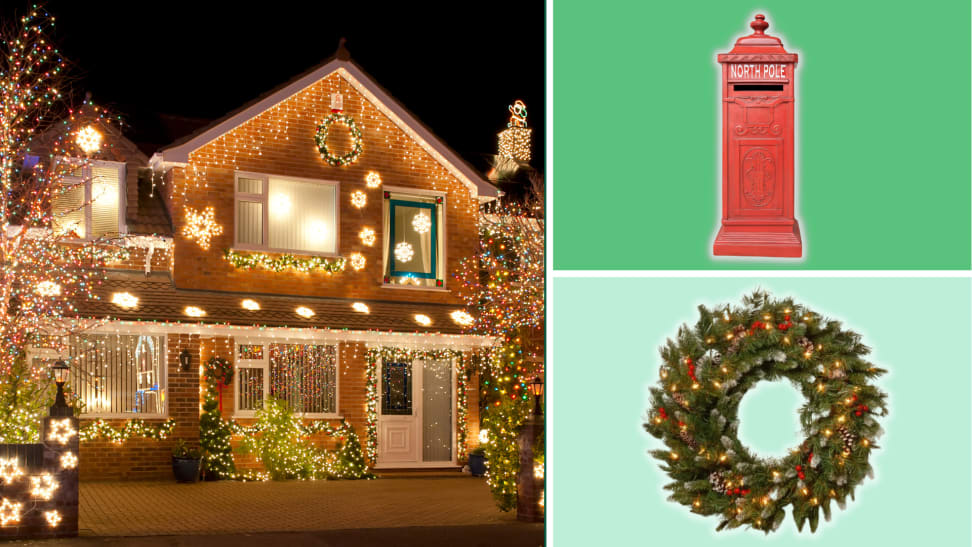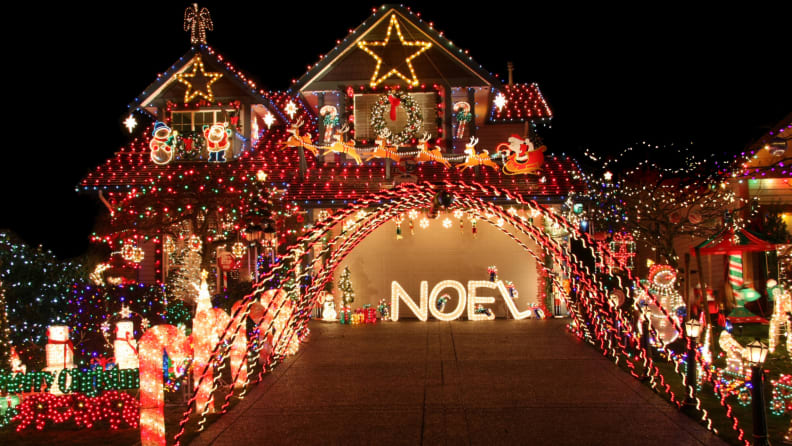How to create a festive outdoor holiday light display
Stay safe, and don’t go overboard
 Credit:
Reviewed / Getty Images / Fotomicar / Balsam Hill / The Holiday Aisle
Credit:
Reviewed / Getty Images / Fotomicar / Balsam Hill / The Holiday Aisle
Recommendations are independently chosen by Reviewed's editors. Purchases made through the links below may earn us and our publishing partners a commission. Prices were accurate at the time this article was published but may change over time.
Outdoor holiday lights are tricky. In order to be successful, they have to be a joyful balance of wow factor and restrained excitement.
Whether you’re throwing caution to the wind and channeling Clark Griswold or you’re looking for a more composed display reminiscent of a Currier and Ives painting, we’ve tapped a few experts for tips on how to achieve a magical holiday lighting display.
Install your lights safely

Avoid disaster this holiday season by putting safe practices into action during decoration time.
Yes, you’re excited about your potential to light up the night, but Ross Harke, co-founder of EverLights, a company that makes “permanent” outdoor lights for the home, wants you to start your task well grounded.
“Christmas decorating leads to more than 15,000 injuries, sending people to the emergency room with falls being the highest cause at 34%, according to the Consumer Product Safety Commission (CPSC),” he explains.
To stay safe, avoid these locations for your light display: In the ground or grass, in hard-to-access areas or areas that require extension cords for power, hung around the pool or hot tub, and any low-hanging areas children can access.
Keep it close and concentrated
While your large yard might spark excitement for tons of sprawling twinkles, Blythe Yost, CEO of online landscape design company Tilly, suggests keepings things close to home for the best display.
“The most efficient and effective lights are closest to the door,” she explains. “Landscapes are perceived differently than houses, and the further lights get from the house the more are needed to make a statement.”
Don’t go too big

Refrain from "going big or going home" this holiday season.
Despite what the Griswolds may tell you, Harke says there is such a thing as overhanging lights. “Too many lights create a single note without contrast,” he explains.
To create a show-stopping display without sensory overload, start out with a timeless look of lights on your roofline.
“Use this as the anchor for the rest of your decorating,” Harke says.
Next pick one or two additional areas: Deck railings, bushes leading to the front door, one or two accent trees, a wreath, windows or doors, or on unique architectural features.
“Try adding a focal point to attract everyone's attention,” he says. “This could be a single tree wrapped with lights, a large lighted wreath on the front door, or a brilliant holiday light path on the sides of your walkway.”
Choose to swag over wrapping when it comes to stringing a tree

Consider swagging your tree as an alternative method.
If you do decide on making a tree your superstar, decide whether you’re all in.
Yost says, “The most intensive lighting undertaking is wrapping deciduous trees.” It takes many strings of lights to effectively illuminate your tree. “If you want to light trees, but don’t want to spend a zillion hours (and dollars) on lights, consider using the swag method where lights are hung rather than wrapped.”
Keep in mind, in for a penny, in for a pound. “if you start wrapping and switch to swagging it’ll look like you got bored and cheaped out!”
Include the neighborhood
Don’t keep all the fun to yourself. Harke suggests that if your neighbors are willing, you can “decorate a street lamp nearby to look like the North Pole. This can be a fun neighborhood initiative to wrap lights up the pole and attach a North Pole sign.”
Put a “Letters to Santa” box up for a tradition the kids won't forget.
Pump up the color

You can't go wrong with a classic.
Colored LED lighting with patterns is an instant way to stand out from the rest, according to Harke. Since you may already be working with a white canvas (hello, snow), adding a pop of seasonal color can bring an unexpected holiday treat.
Harke says, “Colored LED lights can be programmed to a near infinite amount of colors, brightness, and patterns. You could have a unique look each night. These are a favorite amongst kids.”
Yost agrees, “I tend to be a purist with outdoor lights and err on the side of white, but if you want to add color do it in an intentional way. A little bit of color on a winter’s night goes a long way.”
Consider tempering by mixing colored strands with white when lighting the same object. “Also, be very careful when using single colored strands, as they can seem overly saturated,” she advises.





